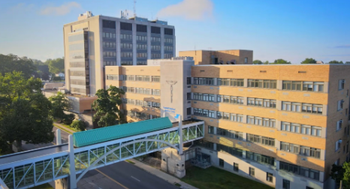
AMA president warns of growing physician shortage: ‘It’s an urgent crisis’
In a speech at the National Press Club, Jesse Ehrenfeld said the problem stands to get worse in the coming years unless policymakers take action.
The nation’s physician shortage is no longer a prediction or worst-case scenario, Jesse Ehrenfeld says.
It’s a reality, and the problem is growing worse.
Ehrenfeld, the president of the American Medical Association, spoke about the physician shortage at the National Press Club Wednesday. He pointed to the high levels of burnout among today’s doctors, which is playing a role in driving some out of the profession. He also outlined steps to address the shortage of doctors.
“The physician shortage that we have long feared, and warned was on the horizon, is already here,” Ehrenfeld says. “It’s an urgent crisis … hitting every corner of this country – urban and rural.”
He cited estimates of more than 83 million Americans who live without easy access to a primary care physician.
“While our current physician shortage is already limiting access to care for millions of people, it’s about to get much worse,” Ehrenfeld says.
He also pointed to estimates from the Association of American Medical Colleges of a physician shortage of at least 37,000 over the next decade, and said the shortage could reach more than 100,000.
The Physicians Foundation released a report last month that found that
Ehrenfeld shared his own personal experience about the loss of a friend, an emergency physician, who died by suicide two years ago.
“He was an energetic and loving soul … a brilliant and caring doctor … who felt the weight of the pandemic on his shoulders,” Ehrenfeld said. “He struggled to get out from under it. I knew he struggled, but I didn’t know how to help him. And he didn’t know how to ask for help.
“I am still deeply troubled by his death, just as I am haunted knowing there are thousands of people in his community who can no longer be cared for by him,” he said.
The stress of the COVID-19 pandemic has also taken a toll on doctors, with one in five physicians saying they plan to leave medicine within the next two years, Ehrenfeld says. One in three doctors say they plan to reduce their hours.
The nation’s physician workforce is getting older, he notes. Nearly half of all doctors are over the age of 55, he says.
Ehrenfeld also talked about
“When you adjust for inflation, the payment rate to physicians who care for Medicare patients has dropped 26 percent since 2001, which was my first year of medical school, with additional cuts planned next year,” he said.
In other steps to help keep doctors in medicine, Ehrenfeld called for Congress to pass reforms to the
Ehrenfeld also called for medical boards and providers to
Mental health advocates say doctors and nurses often don’t seek professional help to deal with depression and burnout because they are worried medical boards and their employers will find out about it.
Ehrenfeld noted that many reforms have the backing of not only healthcare professionals but lawmakers in Congress.
“Every day we wait, the size of this public health crisis grows,” Ehrenfeld says.
Getting help








































